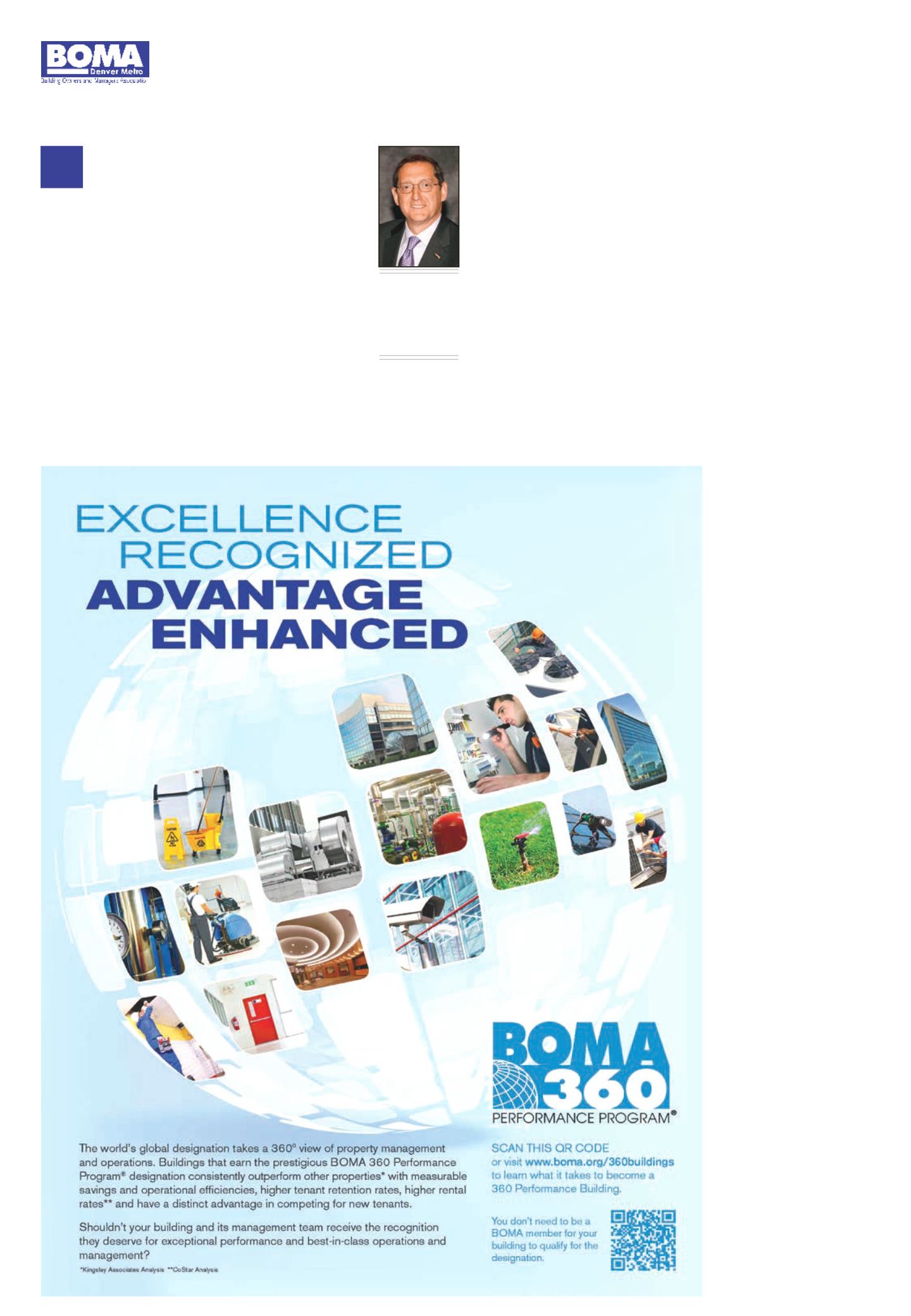
Page 4B —
COLORADO REAL ESTATE JOURNAL
— September 21-October 4, 2016
Spotlight
his is a most inter-
esting time to be
in the commercial
real estate business.
There are several sea changes
underway, particularly in the
office sector.
Today, the commercial
real estate industry revolves
around the customer – that
is, the tenants are in charge.
They not only have all the
information they need at their
fingertips, but also they want
to be serviced very differently.
At this year’s MIPIM
Conference (the international
real estate show for profes-
sionals –
)
in France, there were calls
to move to a service versus
asset-management business
model and calls to give up
our addiction to rent versus
charging for space usage. This
is because customers today
want much more flexibility
and shorter leases. And we
must balance our need to
do the business and get the
investment that matches
their wants.
Companies like WeWork,
Liquidspace, Regus (Logo
slide) and others are provid-
ing business settings with
very different models, and the
deal terms are very different
as well including monthly
arrangements. WeWork has
stated they are driving to
densities of 50 square feet in
their tenant spaces. If steady
revenue streams from build-
ing leases are being chal-
lenged, ultimately the value
of those properties for owners
and investors will be impact-
ed as well. With cap rates low
and profit margins razor thin,
we are in the midst of a busi-
ness revolution.
There also
is a revolu-
tion going on
in terms of
the kind of
workplaces
tenants
want – open
floor plates,
collabora-
tive space,
healthy envi-
ronments,
including the
WELL build-
ing standard
and more.
Tomorrow’s
workforce
wants choice,
authentic workplaces and
transparent environments.
What is the balance between
simpler, leaner, meaner green
office with biophilic designs,
including living walls and
those promoting high density,
activity-based and adaptable
offices enhanced by technol-
ogy and connectivity? The
future will see even more
wearable technology, as well
as augmented technology to
try things out and, of course,
more sensors and Big Data
that everyone will be analyz-
ing looking for advantages.
I also have to highlight a
few predictions from Chris
Lee, head of the real estate
consulting firm CEL &
Associates, including that, by
2025, robotics will reshape
the functional footprint of 60
percent or more of today’s
commercial buildings –
although maybe not quite
like what’s pictured just yet!
Some of his other predictions
include:
•Expect the total office
space square footage per
employee to decline to around
100 sf within 10 years.
Collaborative workspace,
mobile offices, increasing
numbers of employees who
work remotely, greater auton-
omy and work-style flexibility
will drive this change. Office
buildings will become network
orchestrators, not employee
domiciles. Video, messaging
and conferencing are altering
how people interact.
•In a related trend, individ-
uals will meet in cyberspace
with no travel or meeting
space required. In an “always-
on” environment, knowledge
and skills follow the indi-
vidual, and physical space
is less relevant and seldom
necessary. By 2025, virtual
space, holograms and other
Internet-based technologies
will render many of today’s
meetings outdated and inef-
fective. Office buildings,
apartments and retail centers
will have dedicated areas for
virtual meetings.
•Every operational aspect
in property management will
be driven by and connected to
the Internet and each other
as the “Internet of Things”
becomes more commonplace.
•As a result of a more con-
nected commercial real estate
industry, data breaches and
cybercrime will increase dra-
matically. Real estate firms
and asset owners will need
to install devices, systems
and firewalls to protect data
and prevent elevators from
free fall, HVAC systems from
shutting down, safety and
security systems from being
rendered useless and ten-
ant data from being stolen.
Defenses against cyberattacks
will be mandatory for every
real estate firm in the next 10
years.
Much of the drive here is
what is being covered and
reported on about exciting
new mixed-use and corpo-
rate buildings. Projects like
Shanghai Tower’s tiered
construction provides mul-
tiple separate zones for
office, retail and leisure use.
The tallest building in the
world right now also is one
of the most energy efficient.
Also, Amazon’s 3.3-million-
sf Seattle Biosphere project
is a unique, cutting-edge
development and a model
for the future of design. And
Facebook’s Disney-inspired
new California campus
includes a nine-acre green
roof, with a half-mile walk-
ing loop, 400 full-grown trees,
plus whiteboards, Wi-Fi and
plenty of places to sit, so
employees can work al fresco
while collaborating and inno-
vating together.
What a time to be in com-
mercial real estate, especially
if you invest in, own or man-
age existing buildings with all
of this going on around you.
It is a dynamic, challenging
and quickly evolving time to
be in this profession. BOMA
and many of our affiliated
associations are researching
the options and opportunities
around us to create future
value in these buildings as
they compete with the latest
new building stock.
T
Henry
Chamberlain,
APR, FASAE,
CAE
BOMA International
President and Chief
Operating Officer


